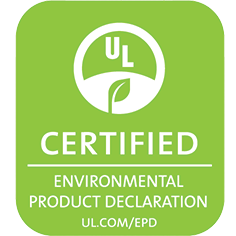Why Steel
Environmental Product Declarations

The low environmental impacts of fabricated structural steel are vetted by third parties and transparently disclosed in Environmental Product Declarations (EPD).
The structural steel industry actively supports the transparent reporting of environmental impacts associated with construction products. Many rating systems (LEED V4), standards (ASHRAE 189.1), green building codes (IgCC), and specific customers require the submission of environmental product declarations (EPDs) for products delivered to the project site. These EPDs rely on the results of life-cycle assessments to provide information on a number of environmental impacts related to the manufacture of the product, including global warming potential, ozone depletion, acidification, eutrophication, and ozone creation. AISC works with our mill members to develop industry-wide EPDs for structural steel produced in the United States. In addition to quantifying the impacts of the mill processes, it is also required that we quantify the industry average environmental impacts per ton of the fabrication process.
AISC develops industry-wide EPDs for three products:
- Fabricated Hot-Rolled Structural Sections
- Fabricated Steel Plate
- Fabricated Hollow Structural Sections (HSS) - developed in conjunction with the Steel Tube Institute
 These EPDs can only be used for mill material produced in the United States. For hot-rolled structural sections, the EPD can only be used for domestic material produced by:
These EPDs can only be used for mill material produced in the United States. For hot-rolled structural sections, the EPD can only be used for domestic material produced by:
- Gerdau
- Nucor Corporation
- Steel Dynamics, Inc.
For steel plate, the EPD can only be used for domestic material produced by:
- Cleveland-Cliffs
- Nucor Corporation
- SSAB North America
For HSS, the EPD can only be used for material produced by:
- Atlas Tube, Inc.
- Nucor Tubular Products (formerly Independence Tube Corporation)
- Maruichi American Corporation
- Maruichi Leavitt Pipe & Tube, LLC
- Maruichi Oregon Steel Tube (MOST)
- Searing Industries
- Nucor Tubular Products (formerly Southland Tube, Inc.)
- Vest, Inc.
AISC member fabricators have the confidence of knowing they can disclose the impacts of fabricated structural steel to meet project requirements.
How can specifiers use these EPDs?
Specifiers can encourage the transparent disclosure of fabricated structural steel's environmental impacts by requiring the submission of EPDs in their bid packages. The following is sample specification language.
STRUCTURAL STEEL
SECTION 05120
1.X FABRICATOR DISCLOSURES
A. A fabricator shall submit an Environmental Product Declaration (EPD) for any of the following products covered in their bid documents:
a. Fabricated hot-rolled structural sections
b. Fabricated steel plate
c. Fabricated hollow structural sections
B. A fabricator who is eligible to use an industry-wide EPD published by the American Institute of Steel Construction may submit it as an appropriate representation for a fabricated structural steel product. Alternatively, a fabricator may submit an equivalent EPD that is developed in accordance with the current version of the North American Product Category Rule for Designated Steel Construction Products.
Where can I find U.S. mill-specific EPDs?
For Hot-rolled Sections
Notes:
- The table represents the most recently published GWP data from relevant domestic structural steel locations as of April 2, 2024.
- The intent of the table is solely to provide a quick reference summary for those trying to comply with GWP procurement policies such as Buy Clean.
- The table is not intended to provide a basis from which policy makers could determine industry average performance. Notably, we estimate that collective LCA uncertainties affect the results in the range of 10-20%. If you are a Buy Clean policy author, see AISC’s Buy Clean Guidance for Structural Steel Products.
- The table is not intended to make direct comparisons between producers. Life Cycle Assessment (LCA) literature (including ISO standards, the North American Steel Construction Products Product Category Rule (PCR), and each EPD in the table) makes clear that EPD comparability is limited and urges caution when comparing EPDs outside the context of a robust whole-building LCA. In order to make comparisons, differences in background datasets, age of primary data, impact assessment factors, LCA methodologies, PCR versions, and more must be considered.
For Plate
Notes:
- The table represents the most recently published GWP data from relevant domestic structural steel locations as of April 2, 2024.
- The intent of the table is solely to provide a quick reference summary for those trying to comply with GWP procurement policies such as Buy Clean.
- The table is not intended to provide a basis from which policy makers could determine industry average performance. Notably, we estimate that collective LCA uncertainties affect the results in the range of 10-20%. If you are a Buy Clean policy author, see AISC’s Buy Clean Guidance for Structural Steel Products.
- The table is not intended to make direct comparisons between producers. Life Cycle Assessment (LCA) literature (including ISO standards, the North American Steel Construction Products Product Category Rule (PCR), and each EPD in the table) makes clear that EPD comparability is limited and urges caution when comparing EPDs outside the context of a robust whole-building LCA. In order to make comparisons, differences in background datasets, age of primary data, impact assessment factors, LCA methodologies, PCR versions, and more must be considered.
For Hollow Structural Sections
Notes:
- The table represents the most recently published GWP data from relevant domestic structural steel locations as of April 2, 2024.
- The intent of the table is solely to provide a quick reference summary for those trying to comply with GWP procurement policies such as Buy Clean.
- The table is not intended to provide a basis from which policy makers could determine industry average performance. Notably, we estimate that collective LCA uncertainties affect the results in the range of 10-20%. If you are a Buy Clean policy author, see AISC’s Buy Clean Guidance for Structural Steel Products.
- The table is not intended to make direct comparisons between producers. Life Cycle Assessment (LCA) literature (including ISO standards, the North American Steel Construction Products Product Category Rule (PCR), and each EPD in the table) makes clear that EPD comparability is limited and urges caution when comparing EPDs outside the context of a robust whole-building LCA. In order to make comparisons, differences in background datasets, age of primary data, impact assessment factors, LCA methodologies, PCR versions, and more must be considered.
For Open-Web Steel Joists
Notes:
- The table represents the most recently published GWP data from relevant domestic structural steel locations as of April 2, 2024.
- The intent of the table is solely to provide a quick reference summary for those trying to comply with GWP procurement policies such as Buy Clean.
- The table is not intended to provide a basis from which policy makers could determine industry average performance. Notably, we estimate that collective LCA uncertainties affect the results in the range of 10-20%. If you are a Buy Clean policy author, see AISC’s Buy Clean Guidance for Structural Steel Products.
- The table is not intended to make direct comparisons between producers. Life Cycle Assessment (LCA) literature (including ISO standards, the North American Steel Construction Products Product Category Rule (PCR), and each EPD in the table) makes clear that EPD comparability is limited and urges caution when comparing EPDs outside the context of a robust whole-building LCA. In order to make comparisons, differences in background datasets, age of primary data, impact assessment factors, LCA methodologies, PCR versions, and more must be considered.
Questions? Contact Max Puchtel, Director of Government Relations and Sustainability, at puchtel@aisc.org
